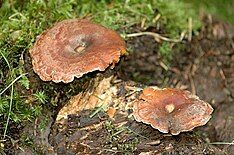User:Sasata/Sandbox/Polyporus badius
| Polyporus badius | |
|---|---|

| |
| Scientific classification | |
| Kingdom: | |
| Phylum: | |
| Class: | |
| Order: | |
| Family: | |
| Genus: | |
| Species: | P. badius
|
| Binomial name | |
| Polyporus badius Jungh. (1846)
| |
| Synonyms | |
|
Polyporus picipes | |
| Polyporus badius | |
|---|---|
| Pores on hymenium | |
| Cap is offset | |
| Hymenium is decurrent | |
| Stipe is bare | |
| Spore print is white | |
| Ecology is saprotrophic | |
| Edibility is inedible | |
Polyporus badius, commonly known as the black-footed polypore, is a species of fungi in the genus Polyporus. This species causes a white rot of dead hardwoods and conifers.
Description
[edit]Fruiting bodies of this species tend to be erect, growing solitary of in groups, sometimes with two or more fruiting bodies arising from a common stipe. The cap is round or kidney-shaped, often lobed or with a wavy margin. When young, the fruiting bodies are convex, then become flat or funnel-shaped in maturity, having dimensions of 5 to 25 cm (2.0 to 9.8 in)* by 1-4 mm thick. The upper cap surface is smooth, glossy, and with radial wrinkles when old. The color of the cap is brown, often darker in the center of the cap and lighter-colored at the margins. The lower surface is white or cream-colored, yellowing when old. Pores are round, 6-8 per mm, with decurrent tubes. The stipe, attached centrally or laterially, is 2 to 8 cm (0.79 to 3.15 in)* long by 0.5 to 1.5 cm (0.20 to 0.59 in)*thick, velvety and dark brown to blackish brown, black and longitudinally wrinkled when old.[1]
Microscopic features
[edit]Spores are ellipsoid or cylindrical, hyaline, smooth, and 7.5-9 x 3-5 µm.[2] The basidia are club-shaped with a narrow base, and have dimensions of 20–30 × 7–9 um.[2]
Habitat and distribution
[edit]This species grows on standing or fallen trunks and branches of various hardwood genera, including Acer, Aesculus, Alnus, Betula, Castanea, Fagus,Fraxinus, Populus, Prunus, Robinia, Quercus, Salix, Tilia and Ulmus.[2]
References
[edit]- ^ Ellis, J. B.; Ellis, Martin B. (1990). Fungi without gills (hymenomycetes and gasteromycetes): an identification handbook. London: Chapman and Hall. p. 156. ISBN 0-412-36970-2.
{{cite book}}: CS1 maint: multiple names: authors list (link) - ^ a b c Ryvarden, Leif (1993). European Polypores (Part 2 European Polypores) (Part 2 European Polypores). Lubrecht & Cramer Ltd. pp. 561–562. ISBN 82-90724-12-8.
